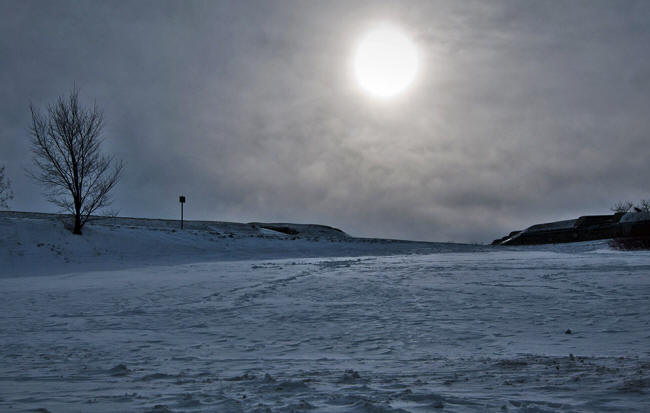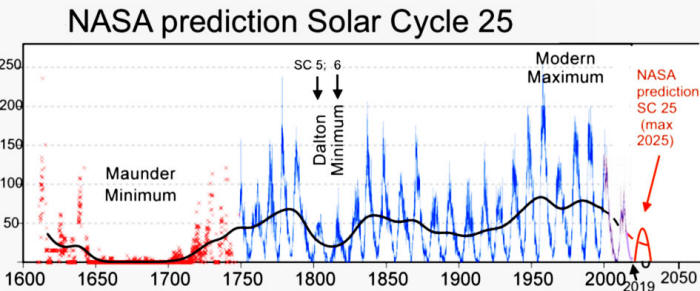|

by Cap Allon
June 18,
2019
from
Electroverse Website

An approaching
Grand Solar Minimum is gaining evermore support. Even
NASA appears to be on-board, with their recent SC25 prediction - though, predictably, they stay clear of
the implications.
NASA's forecast for the next
Solar Cycle 25, reveals it will be
the weakest of the last 200 years.
The maximum of this next cycle - measured in terms of sunspot
number, a standard measure of solar activity level - could be 30 to
50% lower than the most recent one.
The agency's results show that the next cycle will start in 2020 and
reach its maximum in 2025:

NASA prediction added
by SACHA DOBLER
from abruptearthchanges.com
The below is lifted from NASA's official website (www nasa.gov):
The new research was led by Irina Kitiashvili, a researcher with the
Bay Area Environmental Research Institute (BAER) at NASA's Ames Research
Center, in California's Silicon Valley.
It combined observations
from two NASA space missions - the Solar and Heliospheric
Observatory (SOHO) and the
Solar Dynamics Observatory (SDO)
- with data collected
since 1976 from the ground-based National Solar Observatory.
One challenge for researchers working to predict the Sun's
activities is that scientists don't yet completely understand the
inner workings of our star. Plus, some factors that play out deep
inside the Sun cannot be measured directly.
They have to be
estimated from measurements of related phenomena on the solar
surface, like sunspots.
Kitiashvili's method differs from other prediction tools in terms of
the raw material for its forecast. Previously, researchers used the
number of sunspots to represent indirectly the activity of the solar
magnetic field.
The new approach takes advantage of direct
observations of magnetic fields emerging on the surface of the Sun - data which has only existed for the last four solar cycles.
Mathematically combining the data from the three sources of Sun
observations with the estimates of its interior activity generated a
forecast designed to be more reliable than using any of those
sources alone.
In 2008 the researchers used this method to make their prediction,
which was then put to the test as the current solar cycle unfolded
over the last decade.
It has performed well, with the forecast
strength and timing of the solar maximum aligning closely with
reality.
Implications
NASA attempts to paint the upcoming solar shutdown as a window of
opportunity for space missions,
"the improving
ability to make such predictions about space weather are good
news for mission planners who can schedule human exploration
missions during periods of lower radiation."
This is absurd, and serves as yet another example of government
agency obfuscation and half-truths.
NASA is effectively forecasting a return to the
Dalton Minimum
(1790-1830) but gives no mention of,
...associated with it:
-
Like the deeper
Maunder and
Sp÷rer Minimums preceding it, the Dalton
brought on a period of lower-than-average global temperatures.
The Oberlach Station in Germany, for example, experienced a 2║C decline
over 20 years, which devastated the country's food production.
-
The
Year Without a Summer also occurred during the Dalton Minimum,
in 1816.
It was caused by a combination of already low temperatures
plus the after effects of the second largest volcanic eruption in
2000 years:
Mount Tambora's VEI 7 on April 10, 1815.
(For more on the link between reduced
Solar Output and a Volcanic +
Seismic uptick, click
here).
The earthquakes and tsunamis that followed killed tens of thousands
of people living on the surrounding Indonesian islands.
But Tambora's eruption wasn't of much interest to Europe and the U.S.,
not initially at least - the news was focused on the Napoleonic Wars
and the Battle of Waterloo on Sunday, June 18, 1815, in which the
Duke of Wellington defeated Napoleon Bonaparte at the expense of
65,000 men.
The newspapers were preoccupied with the battle right up until the
start of winter in 1815, when the weather turned decidedly whacky.
And by 1816, the climate was dominating headline news as both Spring
and then Summer failed to arrive.
One Virginia resident recalled,
"In June another
snowfall came and folks went sleighing.
On July 4, water
froze in cisterns and snow fell again, with Independence Day
celebrants moving inside churches where hearth fires warmed
things a mite."
Clothes froze on the line in New England, ice on ponds and lakes was
reported in northwestern Pennsylvania in both July and August, and
Virginia had frosts in August.
The temperature occasionally got into
the 90s, but then would drop to nearly freezing in just a few hours.
Crops that had managed to sprout were frozen out in early June,
replanted, and frozen again in July. Very few crops were actually
harvested, and of those that were, the yields were very poor.
In
turn, food and grain prices skyrocketed - for example, in 1815, oats
sold for $0.12 a bushel but by the next year, a bushel would set you
back $0.92.
And the story was the same across the world:
-
The potato crop in Ireland rotted in the ground resulting in
widespread starvation.
-
In England, France and Germany wheat crops failed leading to bread
shortages and food riots and looting.
-
Northern China was also hard hit with thousands of people starving
to death.
-
While in southern Asia, torrential rains triggered a cholera
epidemic that killed many more.
The year 1816 went on to earn another, rather more morbid nickname,
"Eighteen Hundred and Froze to Death".
For more from farmanddairy.com, click
here.
Grand Solar Minimum
Solar Cycle 25 will likely be a mere stop-off on our descent into
the next Grand Solar Minimum - a period of even further reduced
temperatures and crop yields (research Maunder Minimum, 1645-1715).
And there are other researchers still insisting there won't be a
solar cycle 25 at all.
While the excellent analysis from Valentia Zharkova suggests that
all four of the Sun's magnetic fields will go out of phase in 2020,
which blows any IPCC 'warming' out of the water (click
here for
more).
One way or another, the cold times are returning - it's just a
matter of when...
| 


